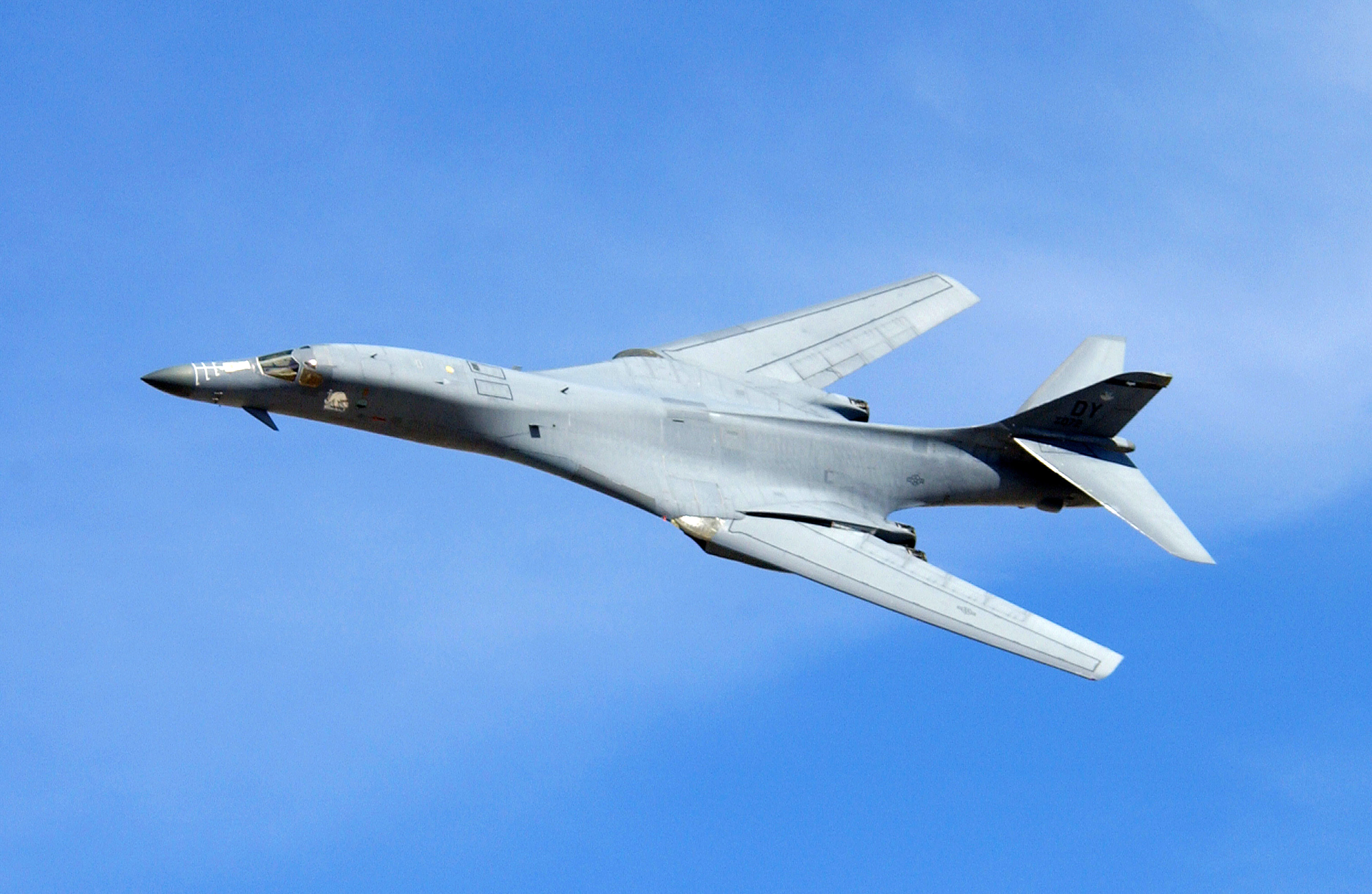by Robert Farley
Over the past week, the failure of the opponents of the Iran nuclear deal to kill it in Congress has become a foregone conclusion. With that in mind, advocates of war with Iran have adopted a new idea: giving Israel the means to attack Iran on its own, without US assistance. The thinking goes that the Israelis, unhindered by Obama’s fecklessness, will have the wherewithal to do what needs to be done. One of the first sightings of the idea came in a Wall Street Journal op-ed last year, when retired Air Force General David Deptula (along with Michael Makovsky) suggested improving Israel’s deterrent capability by transferring B-52s to the air force of the Israeli Defense Forces (IDF).
In recent days, the idea has proliferated. A Washington Post op-ed by Dennis Ross and David Petraeus on August 25 reiterated Deptula’s proposal. Walter Reich, former director of the US Holocaust Museum, recommended that President Obama guarantee Israeli access to Massive Ordnance Penetrators (MOPs) and the means of delivering them. In an open letter to undecided legislators, Robert Satloff of the Washington Institute for Near East Policy listed transfer of the MOP as part of a series of conditions for supporting Israel in the wake of a deal. Thus far, Senator Ben Cardin (D-MD) and Senator Cory Booker (D-NJ) are the only Senate Democrats who have come out in favor of transferring the weapons.
But make no mistake: transferring strategic bombers to Israel is not a good idea. The idea is so terrible that, coming from Deptula, it verged on professional misconduct. Politicians have different requirements, and the fact that the idea is bad for relatively complex reasons means that they have the opportunity to display their pro-Israel credentials, whether as a means of deflecting criticism over support of the Iran deal (most Democrats), or bashing Democrats (most Republicans). But here’s a rundown of what it would mean to send bombers to Israel, and why it would be a bad idea.
MOPs and the Planes that Carry Them
Theoretically, the availability of heavy bombers carrying MOPs gives Israel the ability to destroy Iran’s nuclear facilities on its own, without US assistance. Most analysts agree that the IDF has the capacity to defeat Iran’s air defense network and hit its nuclear sites hard. Some of these sites, however, are buried so deeply that only a MOP could guarantee destruction.
MOPs are very large bombs and require very large aircraft to carry them. The IDF has specialized in multi-role fighter-bombers, such as the F-15 and F-16. These aircraft can (with inflight refueling) reach Iran, but they can’t carry MOPs.
Thus, we would have to give Israel big planes to carry the big bombs. Deptula recommended transferring older B-52 Stratofortresses (or “BUFF,” of which we have a huge surplus at the Boneyard). But some of the more recent commentators have suggested B-1B Lancers (more commonly known as the “Bone”). Both the B-52 and B-1B were designed, during the Cold War, to deliver nuclear payloads to the Soviet Union, but the Bone is a more modern design with much higher speed.
Neither the B-1B nor the B-52 is certified to carry an MOP. Only the B-2 Spirit can do that. However, with sufficient modification (reconfiguring the main weapons bay so that an MOP could be carried), a B-1B could probably make do. However, doing this might run afoul of some of the agreements that the United States has with Russia, which include prohibitions on the export of nuclear-capable strategic bombers and limitations on the reconfiguration and modification of the B-1B specifically. The United States could possibly circumvent this restriction by having the modifications made after transfer.
The B-1B has a couple of advantages over the B-52. As noted, export of B-1Bs modified for conventional missions is not technically illegal under the terms of the START treaty. Second, the Lancer is probably more survivable in contested airspace than the B-52. Assuming a concerted suppression of enemy air defense (SEAD) campaign, the B-1B can get in and out of the target area more quickly than the B-52, reducing its vulnerability to Iranian defenses. That said, the B-1B is not a stealth aircraft and would not survive on its own against an active and alert air defense network.
Thus the Israelis would need to send several aircraft in order to ensure a successful strike, especially given that many analysts believe that the deepest Iranian targets will require multiple MOPs, in succession, to destroy. A 2009 study estimated that an Iranian air defense network equipped with the S-300 surface-to-air missile system (which the Iranians will have before the Israelis ever get any B-1Bs) could cause up to 30% attrition of an Israeli strike package. To hedge against misses, breakdowns, and shootdowns, the Israelis would require a significant B-1B force (some off-the-cuff calculations suggest 8-10 aircraft) in order to generate a high level of confidence in a successful attack. And to carry out the strike, the Israelis would need to accept a level of risk to their bombers that the US hasn’t been willing to accept since December 1972.
US Domestic Politics
Fortunately, the Israelis are much smarter than their friends in the United States. The Israeli air force has no history of flying or maintaining large strategic bombers (the last dedicated bomber operated by the IDF was the B-17, retired in the late 1950s). The learning curve to get a fleet of B-1B crews operational and effective would be steep. The larger the Bone force that the IDF would need to take on, the larger the problems it would cause for the rest of the force.
It’s not impossible that the Israelis could find some other use for the Lancers, but keeping them ready for an Iran strike would prove onerous. The Bone is a complex, moody aircraft, and the US Air Force has struggled to maintain a high readiness rate, despite the availability of tremendous resources and a large fleet of aircraft.
Consequently, the key constituency for this idea lies not in Israel, but in the United States. Republican advocates get to insist that they’re doing their best to defend Israel, and get a tool with which to attack recalcitrant Democrats. Democrats, such as Booker and Cardin, get to throw a sop to constituents nervous about the Iran deal.
Given the unlikelihood that Israel would accept the bombers, the entire proposal seems harmless. Some might argue that the United States would suffer no real loss even if Israel took the aircraft and the MOPs. But this is where the situation gets very dangerous. Iranian compliance with the nuclear deal depends on its belief in US (and Israeli) restraint. If Iran believes that it will be attacked whether or not it complies, then it will not comply. And given the heated Israeli criticism of the deal thus far, it’s hardly a stretch to suggest that Iran could conclude that an Israeli strike is inevitable. Consequently, instead of deterring Iran, the transfer of bombers and MOPs to Israel could convince Iran to make a break for it.
Sending strategic bombers to Israel is a bad idea. It’s bad enough that the Israelis probably won’t take them. But it could get even worse if they decided to make a go of it.
Photo: B1b bomber
Robert Farley specializes in security affairs, writing regularly for the Diplomat, the National Interest, and Lawyers, Guns and Money. He teaches at the University of Kentucky and can be found on twitter at @drfarls.






This idea is so misguided that It is hard to decide where to begin. And it is astonishing that a retired Air Force general would propose it. Both the B-52 and the B-1B are large enough to carry the 30,000 lb MOP, but it is almost inconceivable that, as part of an Israeli attack, that they could reach Iran’s major nuclear sites, and utterly inconceivable that they could then make it back to Israel, or even any third-party neutral country. The B-1A was developed as a supersonic successor to the B-52, but in 1988 it was decided that it could not survive the Soviet air defenses, and the B-1B was developed from it, much slower, designed for penetration at very low altitude flight. But the MOP cannot be dropped from very low altitudes, and each major Iranian site is surrounded with over a hundred AA sites; 23 mm, 35 mm, and 100 mm automatic radar-aimed anti-aircraft cannon; sites for many SAM missile batteries, including the early model US Patriot and SM-1 Standard missiles (the earlier models were optimized for use against aircraft) and several types of modern Russian SAM missiles, and Iranian clones of same. It will take a year or two for Israel to assimilate these large and complex aircraft, and in that time the Iranians will have included the S-300 missiles anticipated later this year, an extremely formidable system, with perhaps five different interceptor missiles to fire in a range of tactical situations. The large descending MOP itself is a good target for many of the defensive systems.
If a B-1B actually made it to an Iranian nuclear site, it would have to pull up to a reasonable altitude to drop the MOP, right in the midst of over 100 AA sites, and there is no chance of it surviving. The MOP is not a “stand-off device”, it is a gravity bomb. The chances of the enormous, lumbering B-52 succeeding is even more remote. They are rarely mentioned. but Iran has about 275 jet fighters, older aircraft, but on average faster than newer aircraft, and adapted to fire modern air to air missiles imported from Russia and China. Their best, MiG-29s with important upgrades, are stationed about 60 miles north of most of the sites.
While the Natanz enrichment site is under “only” 100-120 feet of earth and concrete, the newer Fordow plant is under 280′ of granite, and it is not expected that even one or two MOPs could destroy it. (The US is thought to only have 20 MOPs, which cost millions each.) The main Iranian AA headquarters is 820 feet underground. These are only some of the many reasons why this proposed transfer is a very bad idea, and why Israel itself would never attempt such a mission.
When will the U.S. Politicians and decision makers learn lessons from the mistakes made in the past ? They do not know how to deal with conflicts in the Middle East and Islamic world and have no intention to listen to what the experts are proposing. Look what 2003 Iraq invasion did: all this Islamic terror in the world is the result of hatred created by Iraq war. In ’80s, smart US politicians supported Islamist extremism against Soviets in Afghanistan… Result is that all this region including Pakistan is destabilized and no “force” in the world can kick Taliban out (so sad to say but they kicked the West out). Other examples of failed US foreign policy are Libya and Syria. I believe that if US sends MOPs & bombers to Israel then it will ignite a nuclear war and it will be end of the world/humanity.
I suspect an Israeli strike will use low-yield nukes, on the order of .01 – .02 KT (10-20 tons).
Then they will deny, deny, and the propaganda theme will be “Of course there is radioactivity, these were nuclear sites being bombed!”
Look for it.
It’s a terrible idea politically because the US obviously should not want to give up control of its foreign policy. If Iran must be bombed, it should be the call of the US, not at the whim of an Israeli prime minister.
But it is good to know that the idea is totally impractical from a logistical and military standpoint as well.
JFK: “The USA will never start a war”
But if the Zionist state starts a war then US gets a path and green light to join!